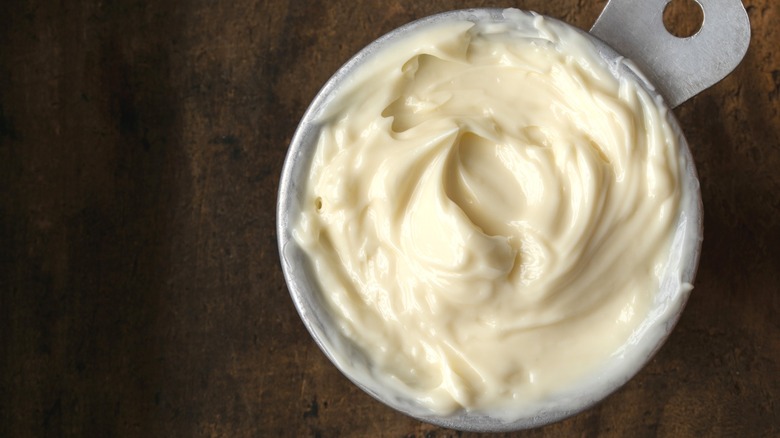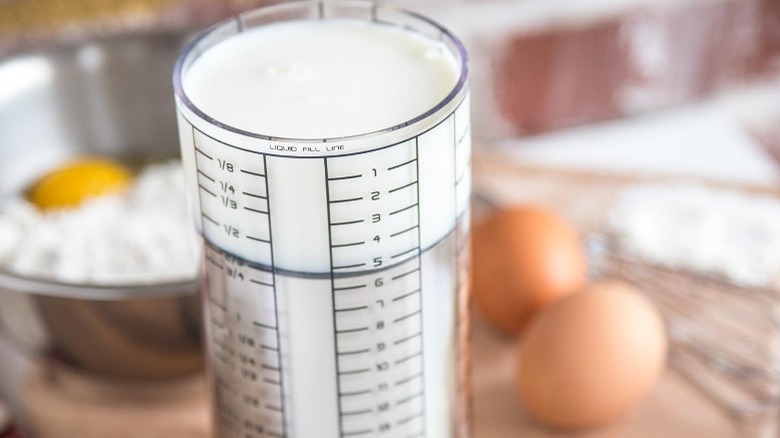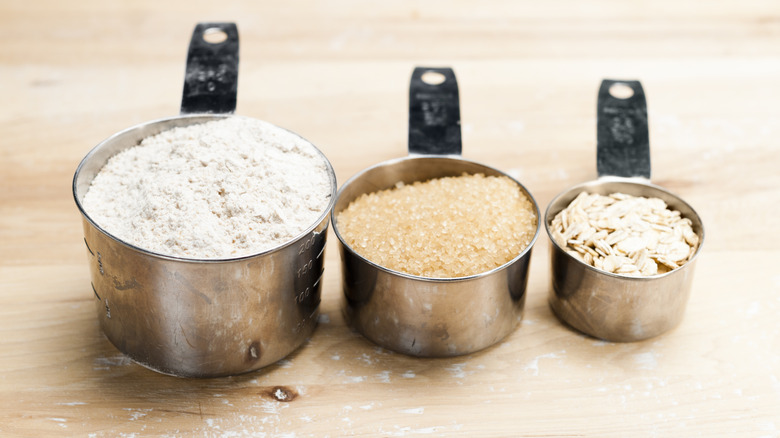Dry Vs. Liquid Measuring Cups: Which Is Better For Mayo?
We may receive a commission on purchases made from links.
To get accurate results when cooking, you can measure ingredients by weight, which is the most reliable route, or by volume in dry or liquid cups. We all know which cups to use for water or flour, but what about semisolids like mayo? Do you reach for your dry or liquid measuring tools? The answer depends on whether or not an ingredient is solid enough to "level off" with a knife or spatula.
Giving it your best guess and pouring mayo into one cup or the other isn't a great idea. A liquid measuring cup always equates one cup of a liquid to eight ounces. Meanwhile, how many ounces go into "one cup" when measured in a dry measuring cup depends on the ingredient. For instance, one cup of all-purpose flour in a dry measuring cup equals 4.5 ounces, not eight. Ignoring the difference can throw your recipe off by a lot.
Liquid measuring cups also allow for extra room at the top to prevent spills, but dry measuring cups are filled up to the top and require you to level off excess ingredients for accurate measurements. You use a knife or offset spatula to sweep the excess away. Bringing it back to mayo, the best option is a dry measuring cup, as mayo is thick enough to level off after piling it in. The same goes for other semisolids, like peanut butter and sour cream.
Swap out your dry and liquid measuring cups for a multipurpose tool
Though separate dry and liquid measuring cups get the job done, you can save yourself some confusion by investing in a tool that will work for any kind of ingredient. One such tool is an adjustable measuring cup, a cylinder-like tool that can be twisted to adjust the measurements printed on the side. This allows you to measure any liquid, dry, or semisolid ingredient. These tools also use a plunger to push out your ingredients, meaning you don't have to worry about leaving half of your molasses in the measuring cup. Best of all, adjustable measuring cups are more accurate than dry or liquid cups, and you can buy one for as little as $10 on Amazon.
With that being said, kitchen scales are the best alternative to traditional measuring cups, and are an essential kitchen tool for any beginner baker. Finicky baking recipes will always turn out better with weighted ingredients. Scales work for both dry and liquid ingredients – as well as any questionable ingredients in between — and are even more accurate than an adjustable measuring cup. Digital scales can also do unit conversions for you, so there's no need to break out a pen and paper and get to calculating. Scales range in price from as little as $10 to over $50, so there's certainly an option out there to fit your budget.
Tips for using measuring cups in your kitchen
No matter what kind of measuring cup you're using, it's good to follow some general guidelines for the best results. When measuring dry ingredients, always be sure to overfill the cup so you can level it off. Do not pack down your ingredients — with the exception of brown sugar – as this can put a higher quantity into the cup than intended. Instead, gently pour your dry ingredients into the cup and let them settle as they may, then level it.
When it comes to measuring liquid ingredients, you should always read the units at eye level. If you measure liquids from a top view, you'll under-measure, and if you measure from a bottom view, you'll over-measure. Get face-to-face with your cups, instead. You should also keep in mind that liquid ounces are a measure of volume, whereas regular ounces are a measure of weight; they are not interchangeable in your recipes.
As a final tip, when measuring sticky ingredients like honey and molasses, you can coat the inside of your measuring spoon or cup with cooking spray to prevent sticky messes. Your ingredients will slide right out, and you'll get the full amount that you poured into the cup. This is vital for both accuracy and getting your money's worth from your ingredients — a true win-win.



